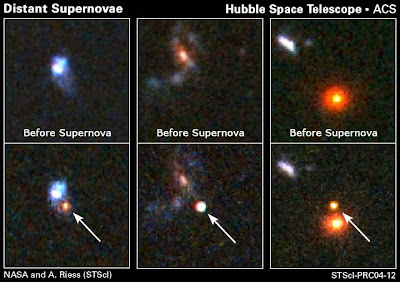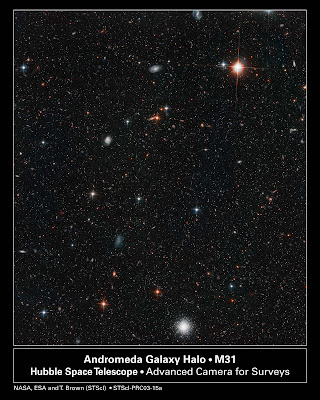
What is dark energy?
Dark energy is an unknown form of energy that radiates from deep space. It behaves in the opposite manner from gravity. Rather than pulling galaxies together it pushes them apart.
2. Did anyone predict dark energy?
Dark energy is a complete surprise. However, Albert Einstein theorized the existence of a repulsive form of gravity in space that would balance the universe against normal gravity and keep it from imploding. Einstein called it the cosmological constant.
3. How does dark energy affect the universe?
Dark energy makes up the bulk of the universe's mass/energy budget. If dark energy is stable the universe will continue expanding and accelerating forever. If dark energy is unstable the universe could ultimately come unglued to the point where stars, planets and even atoms come apart, a doomsday scenario called the "big rip." Dark energy might also flip such that is becomes an attractive force and causes the universe to implode in a "big crunch."
4. How can Hubble "see" dark energy?
Hubble can measure the faint glow of distant supernovae, stars that exploded billions of years ago. Supernovae trace the expansion history of the universe, hence, how dark energy "pushed" on space over the past epochs. Every second a star explodes somewhere in the universe, so it's a matter of Hubble looking in the right place at the right time.
5. Does Hubble prove how dark energy really behaves?
These latest Hubble observations show that dark energy is not changing its behavior over time, and so may be the "constant" Einstein predicted. However, more observations are needed over the coming decade.
6. What happens to this research after Hubble stops working?
There will be a hiatus of at least several years in this type of research until some future space telescope with a wide field of view picks up where Hubble left off. This type of research cannot be done with even the largest ground-based telescopes, even those outfitted with adaptive optics for improving image quality.

The Crab Nebula is a supernova remnant, all that remains of a tremendous stellar explosion. Observers in China and Japan recorded the supernova nearly 1,000 years ago, in 1054.

Quasars reside in a variety of galaxies, from normal to highly disturbed. When seen through ground-based telescopes, these compact, enigmatic light sources resemble stars, yet they are billions of light-years away and several hundred billion times brighter than normal stars. The following Hubble Space Telescope images show examples of different home sites of all quasars. But all the sites must provide the fuel to power these unique light beacons. Astronomers believe that a quasar turns on when a massive black hole at the nucleus of a galaxy feeds on gas and stars. As the matter falls into the black hole, intense radiation is emitted. Eventually, the black hole will stop emitting radiation once it consumes all nearby matter. Then it needs debris from a collision of galaxies or another process to provide more fuel. The column of images on the left represents normal galaxies; the center, colliding galaxies; and the right, peculiar galaxies.
Top left: This image shows quasar PG 0052+251, which is 1.4 billion light-years from Earth, at the core of a normal spiral galaxy. Astronomers are surprised to find host galaxies, such as this one, that appear undisturbed by the strong quasar radiation.
Bottom left: Quasar PHL 909 is 1.5 billion light-years from Earth and lies at the core of an apparently normal elliptical galaxy.
Top center: The photo reveals evidence of a catastrophic collision between two galaxies traveling at about 1 million mph. The debris from this collision may be fueling quasar IRAS04505-2958, which is 3 billion light-years from Earth. Astronomers believe that a galaxy plunged vertically through the plane of a spiral galaxy, ripping out its core and leaving the spiral ring (at the bottom of the picture). The core lies in front of the quasar, the bright object in the center of the image. Surrounding the core are star-forming regions. The distance between the quasar and spiral ring is 15,000 light-years, which is one-seventh the diameter of our Milky Way. A foreground star lies just above the quasar.
Bottom center: Hubble has captured quasar PG 1012+008, located 1.6 billion light-years from Earth, merging with a bright galaxy (the object just below the quasar). The two objects are 31,000 light-years apart. The swirling wisps of dust and gas surrounding the quasar and galaxy provide strong evidence for an interaction between them. The compact galaxy on the left of the quasar also may be beginning to merge with the quasar.
Top right: Hubble has captured a tidal tail of dust and gas beneath quasar 0316-346, located 2.2 billion light-years from Earth. The peculiar-shaped tail suggests that the host galaxy has interacted with a passing galaxy that is not in the image.
Bottom right: Hubble has captured evidence of a dance between two merging galaxies. The galaxies may have orbited each other several times before merging, leaving distinct loops of glowing gas around quasar IRAS13218+0552. The quasar is 2 billion light-years from Earth. The elongated core in the center of the image may comprise the two nuclei of the merging galaxies.

Deepest View of Space Yields Young Stars in Andromeda Halo
MAY 7, 2003: Relying on the deepest visible-light images ever taken in space, astronomers using NASA's Hubble Space Telescope (HST) have reliably measured the age of the spherical halo of stars surrounding the neighboring Andromeda galaxy (M31). To their surprise, they have discovered that approximately one-third of the stars in Andromeda's halo formed only 6 to 8 billion years ago. That's a far cry from the 11-to-13 billion-year age of the stars in the Milky Way's halo.
Why is there a difference in the age range of the stars in the Andromeda and Milky Way halos?
Astronomers think that the collision with another large galaxy or the ravaging of several smaller galaxies scattered the young stars into Andromeda's halo. The newly discovered younger stars in Andromeda's halo are richer in heavier elements than those in our Milky Way's halo, or in most of the small dwarf galaxies that surround the Milky Way. The stars' age spread and chemical make-up suggests three possibilities: (1) Collisions destroyed the young disk of Andromeda and dispersed many of its stars into the halo; (2) a single collision destroyed a relatively massive invading galaxy and dispersed its stars and some of Andromeda's disk stars into the halo; and/or (3) many stars formed during the collision itself. Astronomers say it will take more detailed observations to unravel the evidence of these early cataclysmic events.
2. Why do astronomers call these observations the "deepest visible-light images ever taken in space"?
Astronomers needed to make several hundred exposures to survey the bright and the faint stars in Andromeda's halo. The image shown here was made from 250 separate exposures. The observations were taken from Dec. 2, 2002 to Jan. 11, 2003 with the Advanced Camera for Surveys (ACS), but the total exposure time was 3.5 days. Astronomers needed the lengthy observations because the halo's ordinary Sun-like stars are very faint. In fact, before using the ACS to tackle the halo stars, astronomers had observed only the brightest ones. The sharp eyes of the ACS, however, uncovered about 300,000 stars that astronomers had never seen before.



















